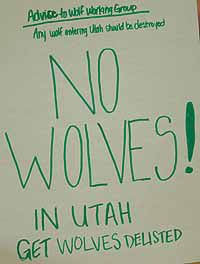| Meeting goers make their opinions known. |
The consensus at the wolf meeting held by the Utah Division of Wildlife Resources on March 18, seemed to be that wolves aren’t welcome in Utah. At least, as far as Emery and Carbon county citizens are concerned. A DWR presentation on the status of wolves was presented. Wolves are found widely across Canada and Alaska. There are three wolf recovery areas in the lower 48 states. These include the Great Lakes states of Minnesota, Wisconsin and Michigan; the states of Idaho, Wyoming and Montana which now contains 760 wolves; the third recovery area is Arizona and New Mexico. This area where 69 Mexican wolves have been reintroduced hasn’t seen the success that the other two recovery areas have seen with the Rocky Mountain wolves.
A wolf pack can cover an area of 250 miles as their territory and will travel up to 500 miles to find a new area. Sightings of wolves in Northern Utah has been recorded and any trapped have been moved back to Yellowstone Park. Sightings of wolves continue as they attempt to establish packs in the state. The criteria for the removal of federal protections was exceeded in 2003 when the biological criteria of 30 pairs that raised two pups was met. Idaho and Montana have wolf management plans in place and Wyoming is still working on their plan.
Utah is divided by I-70 with the Rocky Mountain wolf area north of I-70 and the Mexican wolf territory below I-70. The Rocky Mountain wolf is listed as threatened and the Mexican wolf is still an endangered species. This puts Utah in a unique position with wolves being under a different level of protection. The state will be the authority on the northern part of the state and the federal regulations will govern the wolves south of I-70.
In 2003, the legislature determined when the major federal protections are removed; the Division of Wildlife resources becomes the management agency as it does for other wildlife. The issues of livestock depredation was also included and private land owner issues. The Ute tribe is also very interested in the wolf and they are against any recovery zones in Utah and they wish to continue to be consulted as the wolf management plan moves along.
The recommendations made at the meeting will go back to the Wolf Working Group in a report. The wolf management plan is due out in 2005 with a rough draft scheduled to be ready by May 2005 to bring before the Regional Advisory Council. The Utah people are getting in on the ground floor by making their concerns known during the development phase of the plan.
Attendees at the wolf meeting gathered in groups to discuss issues and suggestions and advice for dealing with those issues. They were instructed to write the information down on large sheets of paper which were then displayed on the wall. Groups worked together to come up with issues concerning them. Some of these concerns included: loss of current elk and deer herd numbers and we already have enough predators; who will compensate livestock owners for losses; where in Utah is there enough space for wolves?; feds don’t care about local issues; any money used to compensate livestock owners could be better spent on wildlife programs; change boundary from I-70 to the Utah-Arizona border; don’t allow wolf packs to become established; expect revenue loss from decreased elk and deer herds.
Advice listed: Do everything possible to keep wolves out of Utah; create a task force to make sure wolves do not establish in Utah; develop a management plan quickly; assign someone to monitor wolf activity in Utah; manage wolves by total numbers and not breeding pairs; do not manage wolves by emotion; delist the wolves.
Ten wolf planning meetings are being held statewide. Brent Stettler from the DWR said that a Wasatch Front meeting was attended by 200 people who were overwhelmingly against any wolves in Utah. The meeting held in Moab was pro-wolf citing a complete ecosystem with wolves as predators to control the game population as a viable issue. This theory eliminates hunters and is popular with animal protectionists.

